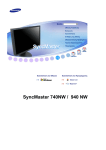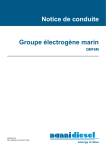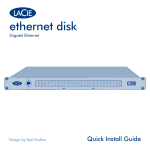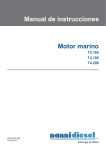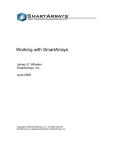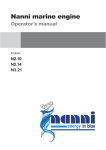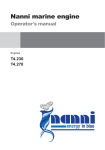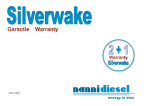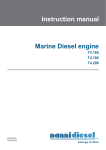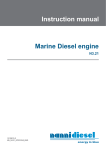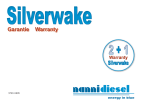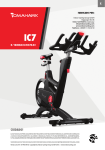Download notice generale couleur-en
Transcript
User manual User manual for NANNI DIESEL engines Reference: 970 313 180 TABLE OF CONTENTS 1. INTRODUCTION • Presentation • Servicing and spare parts • Safety indications • Protection of the environment 2.LIFE AT SEA • Introduction to navigation • Safety on board 3. ENGINE IDENTIFICATION p.1 p.5 p.6 CAUTION This symbol is used to indicate safety measures or to draw your attention to dangerous practices which could result in physical injury or damage to the boat or its components. The engine user should take all the necessary precautions relative to handling and protection and should contact a professional for advice whenever necessary Failure to observe the safety instructions can result in : Physical hazards, danger of environmental pollution (dangerous substance leaks), danger to equipment with risk of failure of essential engine functions). ENVIRONMENT This symbol refers to important instructions relative to protection of the environment. 1.INTRODUCTION • Presentation SAFETY SYMBOLS Thank you and congratulations for purchasing a NANNI DIESEL product. Your NANNI DIESEL engine is a product of NANNI INDUSTRIES quality engineering and production. Your engine is built with the finest materials in accordance with precise specifications and strict production methods. Your NANNI DIESEL engine will provide you with a reliable source of power for your boat for many years to come. Correct installation of the engine on your boat is of the greatest importance for safe navigation and protection of the environment. The following symbols are used in the manual to indicate a safety hazard. The symbols are intended to draw your attention to elements or operations which could be hazardous to you or other users of this engine. Carefully read the safety guidelines given with these symbols. Be sure to read the safety instructions and rules before commissioning your engine. Our engineers at NANNI INDUSTRIES are among the world's finest. Their experience and knowledge of the sea, combined with the technical skills and experience of the engineering teams at MAN, KUBOTA and TOYOTA guaranty you the highest level of performance, reliability and savings available. *All the information and specifications contained in this manual are based on the technical data applicable on the date of publication. This manual is subject to modifications and updates. NANNIDIESEL Uses and recommends DANGER This symbol refers to an extremely serious danger with high probability of resulting death or irreparable physical injury if specific, appropriate measures are not taken. WARNING: Your engine must be installed by a Shipyard or a representative qualified by NANNI INDUSTRIES in compliance of the on-board installation instructions. Page 3 sur 24 English 4. INSTALLING THE ENGINE p.8 • Principles relative to check of installation performed • Preparation before commissioning 5. OPERATING PRECAUTIONS p.10 • Engine and fluid recommendations • Regular checks to be performed 6. OPERATION p.11 • Engine operation • Instrumentation • Operating table 7. SERVICING AND MAINTENANCE p.15 • Work safety in engine compartment • Servicing and maintenance tables • Logbook • Detailed operations • Wintering • Extended storage 8. TROUBLESHOOTING p.23 WARNING This refers to a danger which could result in serious physical injury or death if specific, appropriate measures are not taken.. User Manual This manual contains all the information required for correct operation of your engine. With a network of agents and distributors in more than 50 countries, NANNI INDUSTRIES guaranties your engine throughout the world. Whether it be parts, labor or simple advice, everything has been thought out to ensure you the best possible service. Don't hesitate to contact your approved NANNI DIESEL dealer or to browse our Internet site at www.nannidiesel.com. Happy sailing! Carefully read this manual before using your engine. Always observe the safety guidelines. WARNING: To ensure correct, long-lasting operation of your marine engine, the engine must be used in a way which is compatible with the engine's definition and to its transmission (type of boat, operating time and rpm speed). • Servicing and spare parts Our marine engines are designed to ensure excellent operating reliability and a long service life. The engine user is responsible for all safety inspections and servicing, and observance of the maintenance instructions detailed in this manual. All maintenance must be performed by a NANNI INDUSTRIES-approved specialist. Component wear and servicing costs naturally generated by use of the engine do not represent manufacturing faults or material defects with respect to the terms of the warranty. The performance and reliability of your engine depend on application of the operating, servicing and maintenance instructions described in this manual. We strongly discourage any changes to the engine rpm speed settings or any other technical changes (accessories, spare parts, coupled equipment …) which are not approved by NANNI INDUSTRIES. We decline any responsibility for interventions which have not been performed under our control. Definition of application: The Silverwake warranty is defined either for a «pleasure boat" or for a "commercial" use of the engine. For more information concerning the details justifying the "pleasure boat" designation, refer to our Silverwake warranty book. The clutch disks are not guarantied on gear boxes equipped with trolling valves. For all commercial or professional applications, contact NANNI INDUSTRIES; we will propose a warranty suited to your specific utilization needs. • Safety indications : This manual has been drawn up to allow you to make the best use of your engine and its equipment. This manual contains important instructions which must be observed when using the engine. Make sure you have thoroughly read this manual. The manual must always be available at the location where the engine is used. Handling the diesel engine can be very dangerous; always observe the safety guidelines. Safety symbols on engine : Different information is given in the form of logos directly on the engine. This information is intended to allow you to quickly locate certain components and to warn you against possible hazards when intervening on the engine. Symbols : This symbol, indicated on the engine, means that you must read the manual before performing any operations on the engine. This symbol points to electrical hazards. This symbol points to hot parts where there may be a significant risk of burns. This symbol indicates that there may be a fire hazard. This symbol indicates that you must not smoke or produce any flames or sparks in the immediate area as the area represents a fire hazard under these circumstances. This symbol indicates an area where there are pressurized fluids. This symbol indicates dangerous rotating parts of the engine. This symbol locates the degassing ports. Page 4 sur 28 User manual This symbol locates where you can check the coolant level. This symbol locates where you can check the engine oil. This symbol locates the engine heat exchanger port. This label indicates that you must distribute and balance the lifting efforts. Safety rules: YOU MUST OBSERVE SAFETY RULES - - THE FOLLOWING Observe the warning and caution labels on the engine. Remove the ignition key and close the battery switch before intervening on the engine and its equipment. Close the engine cover and install the protective equipment before starting up the engine. Always keep the work area around the engine clean. Store all flammable liquids outside the engine compartment. Never use the engine when under the influence of alcohol, medication or drugs. WEAR PROTECTIVE CLOTHING - To avoid physical injury, stay away from rotating components and never wear baggy clothes near an engine which is running. - Use safety equipment such as goggles, gloves, etc. as may be required when around the engine. EXHAUST GAS PREVENTION - Run the engine in a properly ventilated space, clear of people and animals. Accumulated exhaust gases can be poisonous. PRESSURE - Do not open the coolant plugs or oil plugs when the engine is running or when it is hot. Release all pressure in the circuits before removing plugs. - Do not check for possible pressure leaks with bare hands. Always wear gloves. Pressurized fluids ejected can cause serious injuries. In the event of an injury by a fluid jet, immediately contact your doctor. BATTERY - A highly explosive, inflammable and volatile gas mixture is formed when the battery is charging. Never smoke near the battery or bring any flames or sparks near the battery. - Never short-circuit the battery terminals. - The battery electrolyte is highly corrosive. Always wear gloves and protective goggles. ELECTRICAL WIRING - Switch off the engine and open the battery switch before any intervention on the electrical equipment. - Check the condition of the cables and electrical wiring; a short-circuit can cause a fire. - Check that all connections are properly tightened. DISCARDING USED FLUIDS - Fluids used in operation of the engine represent a health hazard. Carefully read the instructions on the product packaging. - Observe all environment protection rules as concerns discarding of oil, fuel, coolant, filters and batteries. Page 5 sur 24 English This symbol locates the oil drain drain port. FUELS AND LUBRICANTS - Stop the engine when filling the fuel tank or the oil reservoir. - Never smoke or bring a flame near to the engine when filling with fuel. - Wear gloves when searching for a possible leak. - Hot oil can cause burns, allow the engine to cool before inspecting the oil level, changing the oil or the oil filter cartridge. - Always use fuels and lubricants recommended by NANNI DIESEL User Manual • Protection of the environment The sea is a wonderful playground for pleasure boaters. Throughout time, it has nourished our imagination through such major authors as Jules Verne or Hemingway. The aquatic environment is possibly the least known of our planet which represents a wealth of unknown resources and an ocean of mystery. The beauty of our coastlines and the cleanliness of the sea depend on each person's individual contribution to the respect and protection of these natural resources. Our engines have been developed to have a minimum impact on the environment. This goal can only be achieved with your full cooperation. For this purpose, you must carefully apply our servicing and maintenance directives and the following recommended practices : situation At quay Recommended practice Check with the harbor master's office for equipment available to limit pollution. situation At resupply station Sort and discard your household waste in the appropriate containers. Ask the fuel pump handler for an absorbing kit if there are any accidental hydrocarbon spills in the water. Clean the boat using biodegradable products to reduce phosphate and nitrate inputs to the environment. Perform sanding and paint gun work only having belted the hull with a cover. Observe all applicable rules as concerns use of anti-fouling paints and preferably use paints which are less harmful for the environment. Take all poisonous and specific wastes to the appropriate disposal areas provided for this purpose. Do not overfill the fuel tank and drip-off the fuel handle in the drain hole before hanging up the handle. Be sure to fill the correct reservoir when filling with water or fuel. Use sanitary blocks to limit waste in the port. Boat Use refit areas made available in the servicing port. and maintenance Do not pollute the rain water networks with solvents, acids, oils and hydrocarbons. Recommended practice Before casting off lines Be sure you have disposed of all waste and other poisonous products in the specific equipment provided for this purpose. Never throw your waste into the When sailing sea. or at anchor Collecting waste on the coastline is more costly than waste placed in a container. Furthermore, Waste thrown over board can have harmful effects : -interfere with navigation -visual nuisance -poison hazard -sanitary hazard -impact on marine animal and plant life. Respect protected areas. Page 6 sur 28 User manual 2.LIFE AT SEA • • Introduction to navigation in Parameters influencing behavior of boat: Distribution of weights. The manner in which the weights (passengers and equipment) are distributed on the boat can have the following repercussions: If the center of gravity shifts toward the rear: -increase in speed and engine rpm speed -in certain extreme cases, pitching of boat -bouncing of bow on rough sea -increased risk of boat taking water by wake wave at end of planing. If center of gravity is shifted forward: -exit from planing facilitated -navigation in rough water facilitated -in certain extreme cases, can cause directional instability. Boat hull. To maintain optimum speed, the boat hull must satisfy the following conditions: The hull must be clean and free of any shells or seaweed. The submerged part of the hull and the transmission must be painted with an anti-fouling product to preserve their surface condition. The hull must be free of any deformations and must be nearly flat where in contact with the water. Check and replace (if necessary) the anodes installed on the hull, the appendages and transmissions. For the size and choice of type of anode, contact a qualified technician. The anodes are different depending on whether you are sailing on fresh or salt water. Never paint the anodes. Refer to the applicable regulations concerning anti-fouling paint. Do not paint the hull over an area of 40mm around the sterndrive. For (extended) anchoring, vegetation can occur on the hull, on the keel and rudder, significantly penalizing the dynamic qualities of the boat. Furthermore, vegetation can obstruct the cooling system and result in damage to the engine (by overheating). Carefully read the instructions manual and make it a habit to correctly and safety operate the engine and all the boat's components. You should be perfectly familiar with the nautical code and the safety at sea rules. Do not hesitate to contact the competent authorities or organizations. Observe the maintenance and servicing guidelines which will ensure the reliability of your engine. Perform the daily visual inspections (chapter 5) before starting and after stopping the engine. Do not perform any maneuvers which are too abrupt and which could catch your passengers by surprise. Be aware that the propeller represents a significant danger for persons in the water; never come too near to persons swimming or to swimming areas. Eddies created at the stern can result in suction of the exhaust gases into the cabin. In this case, do not open any hatch or valve of the boat and try to change some of the sailing settings (speed, distribution of weights…). Only fluids recommended by NANNI INDUSTRIES should be used. Observe the load and operating capacities of your boat. Check your boat on-board safety equipment. Do not consume alcohol or drugs. Be fully informed as to your area of navigation and avoid dangerous locations. Know how to recognize weather conditions and navigate cautiously with respect to weather conditions. Always inform someone as to your sailing plan (destination and time of arrival). Stay alert and aware of surrounding areas. To get the most from your sailing pleasure, it is always best to adopt a responsible and cautious attitude. Contact your local authorities for all applicable laws and restrictions relative to boats in your sailing area. You should have a minimum number of safety equipment items on board to handle the most critical situations. A non-exhaustive list is proposed. We recommend that you contact the competent organization as to the applicable legislation by which your home port is concerned. Nanni Diesel can supply a first-aid kit which we recommend that you have on board. Page 7 sur 24 English Where to get training? Various organizations can provide training navigation and safety at sea: Coast guards associations Sailing clubs Red Cross Sea and waterway police This is a limited list given for your reference. Safety on board User Manual Safety guidelines: Safety equipment The safety equipment is primordial. It is there to ensure your safety and the safety of your passengers. Make sure your safety equipment is in good operating condition and is not obsolete. Find out about the mandatory equipment relative to your flag and sailing area. 3.ENGINE IDENTIFICATION On all correspondence, requests for information and spare parts orders, you must indicate the information specified on the engine and gearbox nameplates Refer to the mandatory equipment by country ENGINE TYPE SERIAL NUMBER SPECIFICATION Spare parts and tools Fuel filters Oil filters Fuses Adhesive tape Assortment of clamps for hoses Oil for engine Coolant Tool kit V-belt… For more details, refer to the page with the engine characteristics in the appendices. IMPORTANT: Note the serial number and the designation of the engine model and transmission. Keep a copy of this information in a safe location. The Silverwake warranty contains this information; it forms the reference document concerning the warranty and should be kept in a safe location. The table below gives a non-exhaustive list of the components on our marine engines; your engine may not contain all of these components. Refer to the appendices for views of your engine to locate the various components forming your engine. Attitude Always make sure you have the sea chart for the region in which you will be sailing, and a compass. Carefully study your routes. Determine the distance to be covered and check it against the fuel consumption. Get all the necessary weather information. Inform family or friends about your trip. Inform your passengers on the safety instructions and teach them how to use the safety equipment. Make sure you are perfectly familiar with the nautical code. … The components forming your marine engine are represented in the "appendices" of your manual. The "servicing and maintenance" section often refers to these components as follows: Component number in identification table Ex: 10, refers to the air filter; the associated number is used to identify it on the photos provided in the appendix. Page 8 sur 28 User manual Identification of main components : 1 2 3 4 5 6 7 8 9 10 11 12 13 14 15 16 17 18 19 20 21 22 23 24 25 26 27 28 29 30 31 32 33 34 35 36 37 38 39 40 41 A-9 A-9/A-4 A-9 A-9 A-9 A-9/A-5 A-9 A-9 A-9 A-9 A-9 Fuel supply and exhaust A-9/A-5 A-9 A-9/A-4 A-9 A-9/A-5 A-9/A-4 A-9 Lubrication A-9 A-9/A-4 A-9 A-9 A-9 A-9/A-5 Cooling Alternator Alternator belt Electrical connector Starter Electric motor stopping system Battery (-) connecting cable=ground cable Startup relay Air heater / preheating relay Neutral safety contactor Air filter Injection pump Booster pump Priming pump Acceleration control Turbocharger Turbo drain valve Turbo degassing valve Condensation outlet hole Fuel cooler Fuel filter and water detector Intake air cooler Water injection exhaust elbow Anticorrosion anode Oil filler port Oil drain (suction tube or pump) Oil gauge Oil filter Oil/Pressure switch pressure transmitter Heat exchanger / exchanger body (keel cooling) Coolant filler port A Coolant filler port B Block drain plug Freshwater pump Seawater pump Seawater filter Exchanger drain plug Thermostat-controlled valve Oil cooler for power steering (stern drive version) or gearbox Hydraulic oil reservoir (stern drive version) Gearbox Flexible suspension Function A-9 A-9 A-9 A-9 Parts indicated in italics refer to optional equipment which do not necessarily form part of your engine. Page 9 sur 24 English Page Electric system N. Designation User Manual 4. INSTALLING THE ENGINE • Principles relative to check of installation performed (see pA-6 and pA-7). WARNING: Your engine must be installed by a Shipyard or a qualified representative of NANNI INDUSTRIES in compliance with the on-board installation instructions. NANNI DIESEL engines are known for their ruggedness and reliability. When one of our engines is purchased for the first time or second hand, a collaborative relationship between the engine owner and NANNI INDUSTRIES is initiated. NANNI INDUSTRIES undertakes, under the terms of the warranty, to ensure the after-sales service. As owner, you undertake to carefully read the documentation supplied with the engine: User Manual and Silverwake warranty manual; and to carefully observe the servicing, maintenance and utilization guidelines. Our collaboration is first sealed by the start-up voucher in the Silverwake warranty document. This voucher must be co-signed by the owner and the dealer or NANNIDIESEL center just after commissioning of the engine by a qualified technician. This voucher contains the essential checks to be performed. These checks require a good level of technical understanding. You can consult the technical documentation concerning the installation on request to the qualified technician approved by NANNI INDUSTRIES who has performed the installation. However, this documentation may appear to be too complex. We recommend that you check with the technician to perform these checks with his assistance. List of checks: Engine alignment Engine mountings Tension of belts Battery: level and voltage Fuel circuit: priming and purge Closed cooling circuit: priming and purge Check of engine oil and gearbox oil level / tightening of couplings and drain plug Control unit: check of accelerator and gearbox cables Gearbox: check of Forward/Reverse controls and trolling valve (if equipped) Instrument panel: check of indicator values and audible/lighted alarms. The seawater tap for lubrication of the stuffing box should not be installed on a sailboat. • Engine oil can injure your skin – Always wear gloves Note: There is a specific installation configuration called keel cooling. The main feature of this installation concerns operation of its cooling system which consists of a closed circuit only. The circuit is submerged at locations in the seawater by which it is indirectly cooled by thermal conductivity between the envelope and the seawater. • Preparation before commissioning Once the engine has been installed on board and before removing the covers blanking covering the various ports, clean the outer surfaces of the engine. These operations must be performed by the shipyard or by an approved workshop. General verification. See SILVERWAKE® warranty conditions. For reasons concerning transport, certain engines are supplied empty of any operating fluids. In all cases, you must: -Check the fluid levels and, if necessary, fill the engine and transmission reservoirs with oil. -Fill the exchanger with coolant and perform the degassing operations. -Check the tension of the belts. -Check the tightening of various couplings and drain plugs (water and oil) -Check the tightening of the electrical lugs, battery terminals, battery switch, connection of extensions, level of electrolyte in batteries. -Check the acceleration control. -Check that the "accelerator and gearbox" lever(s) are properly synchronized. Engagement of the clutch should be completed when you begin to accelerate. -Perform a final check of the attachments and a visual inspection of the overall engine-propulsion unit. If necessary, perform any paint touch-ups which may be necessary on the unit and its accessories. DANGER: • Never bring a flame or spark near the battery. An extremely explosive gas mixture forms when the battery is charging. Do not short-circuit the battery. • The battery electrolyte is highly corrosive: if battery acid comes into contact with the skin, wash immediately with soapy water. If battery acid is projected into the eye, rinse thoroughly with water and immediately contact a doctor. - Always start by the positive terminal when connecting the battery cables. - Always start by the negative terminal when disconnecting the battery cables. WARNING : • Do not spill fuel or lubricant on the engine. • The fluids used for operation of the engine represent a health hazard. Page 10 sur 28 User manual Note: Modern diesel engines are precision machines which require high quality fuel and lubricant. Fuel circuit Composition Main filter Seawater / fuel cooler (if equipped) Booster pump (if equipped) Injection pump High pressure injection tubes Injectors Fuel circuit purge -Check the fuel level in the fuel tank. -Open the fuel valve, then open the purge screw on the upper part of the filter 20. Use the priming pump 13 to pump. Close the screw when there are no more air bubbles. In the event of total unpriming of the fuel circuit, proceed as follows : -Loosen the supply tube of injector No. 1 and turn the engine using the starter until fuel appears. Close the nut and proceed in the same way for the other injectors. -Start the engine and check for any leaks. DANGER: - Do not smoke or bring any flame or spark near the engine. - Always sponge up any fuel spilled and throw away any object which may contain hydrocarbons in an appropriate location to protect the environment. Cooling circuit The cooling circuit comprises two different circuits: the closed circuit with coolant and the open circuit with seawater. The circuit may comprise a single circuit only as in the case of a keel cooling configuration. This is a specific installation which you can see on our Internet site: www.nannidiesel.com Seawater circuit This circuit comprises a pump, a freshwater/seawater temperature exchanger, a supercharged air cooler (if equipped), a fuel cooler (if equipped), a gearbox oil cooler (if equipped) and an exhaust elbow. Coolant Recommendations for first startup. -Check the tightening of the drain plug 36 and open the vent plug 31. -Prepare a permanent anti-freeze mixture with 50% antifreeze and 50% fresh water. The required quantity is indicated in the table of technical specifications. Pull the mixture into the filler hole 30 then close the vent plug when the mixture appears. Continue filling up to the maximum level. Possible top-ups in the future should be performed using fresh water only with the engine cold. Start the engine and top up the level. Check for any leaks. Every two years, at the start of the season, fully drain the cooling circuit, clean it with fresh water and fill it in accordance with the above instructions (see SILVERWAKE warranty conditions). DANGER: -The coolant must be filled with the engine stopped and cold – Do not smoke or bring a flame near to this area. -Keep away from rotating components when the engine is running. CAUTION: Never add pure antifreeze. Use of additives or other types of coolants can result in formation of insulating deposits and overheating of the engine. Never use all-season, ready-to-use products. Connection for hot water An installation for heating the on-board water can be connected (contact your NANNIDIESEL agent). Seawater filter A water filter must be installed between the pump and the seawater intake. This filter should be checked and cleaned regularly. CAUTION: Before starting up the engine, check that the seawater intake is open. The seawater pump rotor can be damaged if run dry for only a few seconds. After cleaning the seawater filter, carefully close the cover to prevent the seawater pump from sucking in air. Note: The information concerning the electrical components and their wiring is given in appendix pA-10. Page 11 sur 24 English Lubrication of Engine and Gearbox Engine -Oil pump lubrication system, pressure regulated by discharge valve. -Oil filter implementing throw-away cartridge Transmission See separate specifications Filling with engine oil The engine oil is poured through the port located on the rocker gear cover by unscrewing the plug (for more information, refer to the servicing section). Check the oil level using the gauge. Never fill with oil past the maximum mark. Note: The oil qualities and quantities are indicated in the technical characteristics table (given in appendix). Closed circuit with coolant This circuit comprises a pump driven by a crankshaft through V-belt(s), a water temperature exchanger (or an exchanger body for a « keel cooling » configuration), and a thermostat-controlled valve. User Manual 5. OPERATING PRECAUTIONS • Engine and fluid recommendations To maintain your engine's mechanical qualities and extend its service life, we recommend that you observe the following rules: No Rule Details 1 Observe the running-in A new engine is not ready to operate at its full capacity. Applying heavy loads period: first 50 hours of can reduce the engine's service life. The running-in period is intended to operation gradually reduce the friction between the mechanical parts in motion, to smooth and adapt the various parts to the contact surfaces. 2 Allow the engine to warm Allow the engine to warm up for 5 minutes to warm up the oil and facilitate up with no load circulation of the oil in the engine block. Proper lubrication will limit wear of the parts. 3 Select a fuel with a cetane A fuel with a lower cetane value will result in poor combustion and may value>45 generate startup errors and high amounts of smoke. 4 Empty the fuel tank Remove fuel precipitations. Do this the first time after 50 hours of operation, then every 300 hours. 5 Use a quality lubricant A poor quality oil will adversely affect the engine in terms of wear of parts, seizure, etc., and thus reduce its service life. 6 Use tap water for cooling A water which is too hard will result in scale deposits, decreasing the efficiency of the cooling system. This could lead to seizure of the piston. 7 Use an antirust agent in the Corrosion in the closed cooling circuit will accelerate corrosion of the system cooling water while decreasing the engine's service life and the cooling efficiency (the recommended antifreeze contains the antirust agent). 8 Use antifreeze in accordance Antifreeze will lower the temperature at which the coolant will solidify and thus with the climatic conditions prevent the engine from cracking. If you do not use antifreeze under temperatures below 0°C, be sure to drain the cooling water after each use. 9 Do not run the starter for Operating the starter continuously for more than 15 seconds will result in more than 15 seconds damage to the system. As a general rule, be sure to always observe the maintenance and servicing guidelines. Systematically perform the recommended checks. To choose an oil in accordance with the climatic conditions, refer to the table below • Regular checks to be performed: For your safety, you should regularly check certain operating points. For more details, refer to the chapter concerning servicing performed by owner (page 16). Page 12 sur 28 User manual 6. OPERATION • Engine operation When the keyswitch is turned to the start position, heating of the engine intake air is initiated and continues for around 6 minutes with the engine running. Take all the necessary precautions to avoid any contact between a part of the body and the air heater area on the engine (only on 6.420, T6 300 and Z6 300). -Check the indicator lights and the other functions after the engine has been started. -Immediately stop the engine if an alarm sounds, if the temperature rises abnormally or if one or several indicator lights remain lit. If the temperature increases abnormally or if one or several indicator lights remain lit, correct the cause before you restart the engine! -Allow the engine to run at idle speed for 2 to 3 minutes. -Check that the seawater is flowing through the exhaust -If the engine does not start on the first try, repeat the operation waiting 5 to 15 seconds between each try, with the contact off. WARNING: Never cut off the electrical circuit using the battery switch when the engine is running. This could damage the alternator. STOPPING THE ENGINE -Place the lever in the idle/neutral position -Allow the engine to turn at idle speed for a few minutes to stabilize the temperatures and the speed of the turbocharger (if equipped). -Never accelerate the engine before switching it off. -Turn the keyswitch to the « O » (vertical) position. -Close the battery switch, close the seawater intake valve and the fuel supply valve. IMPORTANT: If the boat is towed, stop the engine and close the seawater intake valve to avoid accidental filling of the engine with seawater. TWIN-ENGINE BOATS: When sailing on a single engine, close the seawater intake valve for the engine which is shut down. Do not forget to reopen it before restarting this engine. CAUTION – Inspect the engine and engine compartment for possible leaks. RUNNING IN – WARRANTY INSPECTION Running in During the first 20 hours of operation, we recommend that you use your engine cautiously and that you only take it up to its maximum rpm speed for short periods. Never push the engine rpm speed too hard immediately after starting without allowing the engine to warm up. Warranty inspections All the preventive maintenance operations and their frequencies are described in the SILVERWAKE. ® Warranty book. These inspections are required to validate the warranty. The inspections must be ensured by an approved NANNI DIESEL representative. All new engines are guarantied against defective parts in accordance with the provisions of the SILVERWAKE® warranty book submitted to the buyer when the engine is delivered. Page 13 sur 24 English Startup Before turning the ignition keyswitch -Check the fuel level -Open the fuel supply valve -Open the seawater intake valve -Check the oil levels for the engine and gearbox -Check the coolant level -Close the breaker -Check that the gearbox control lever is in the neutral position DANGER – Carefully close the engine cover and install the protection devices before starting up the engine. -Turn the ignition keyswitch clockwise to the "on" position: the oil alert and battery charge indicator lights come on. Switch to preheating mode (if equipped). The audible alarm sounds. The preheating system is activated. Wait for the yellow lamp to go off then turn the key clockwise to the "Start" position. Immediately release the key once the engine has started. The priming pump is used to fill the fuel circuit if dry, to fill the fuel filter after it has been replaced, and to prime the fuel circuit if the engine has not been run for a certain period of time. To operate the priming pump, turn the knob by 90 degrees counter-clockwise and press as required. Once the operation is completed, turn the knob to its initial position (90 degrees clockwise). IMPORTANT : After several unsuccessful tries to start the engine, search for the cause. Do not continue to try as this could result in water flowing back into the engine through the exhaust system; close the seawater intake valve and try again. Once the engine is started, re-open the valve. User Manual • Instrumentation This section gives a complete list of the various functional instruments and indicators at this time with our marine engines. In the event of a change to the instrument panels, we reserve the right to present the new models in the appendices. The instrument panels can contain all or part of the following indicators. The instruments illustrated are often safety indicator lights; take your time to familiarize yourself with these. Don't hesitate to regularly check these when running the engine. Alert indicators: 5 6 Control indicators: 7 1 8 9 2 11 12 3 4 10 Or with a Fly bridge instrumentation Page 14 sur 28 User manual No Name 1 2 Indicates engine rpm speed. Tachometer and hourmeter Do not push the engine to a high rpm speed when cold. We recommend sailing at a cruise speed 200 rpm below the rated rpm speed. The hourmeter records the engine operating hours. Indicates battery voltage. Voltmeter This meter reflects correct operation of the charging circuit and the alternator. In normal use and after the startup period, the operating voltage is around 14V. Engine pressure oil Indicates the pressure of the oil circulating in the engine. This indicator does not indicate the quantity of oil in the engine! Coolant temperature Operating pressure Engine cold Engine hot Idle Max. Idle Max. Around 2 bars Around 4.5 bars Around 1 bar Around 3.5 bars Indicates engine coolant temperature. In normal use and after the startup period, the temperature should be between 75 and 85 °C. oil Indicates oil pressure which is too low. If the indicator light comes on with the engine turning, stop the engine immediately and search for the cause. Contact a qualified technician. Indicates a coolant temperature which is too high. 6 Coolant If the indicator light comes on with the engine turning, stop the engine immediately temperature and search for the cause. Contact a qualified technician. Indicator light comes on when diesel glow plugs are heating the combustion 7 Preheating chambers. 8 Battery charge Comes on when the ignition switch is on. If the indicator light comes on with the engine running, this means there is a charging fault in the alternator. Stop the engine immediately and search for the cause. Contact a qualified technician. 9 Water present Indicates presence of water in the fuel filter. If the indicator comes on, purge the filter. in fuel filter This is the switch in which the key is introduced for the ignition switch. Certain 10 Key models do not include the preheating position (heat) since it always takes place or automatically. ON switch and The switches respectively control starting and stopping of the engine. On «fly OFF switch bridge» instrumentation, they perform the engine starting and stopping functions while being slaved to the main instrument panel equipped with a key. 5 Engine pressure Voyant/témoin 11 Turbocharger pressure This alert indicator indicates that the air pressure in the turbocharger is too high. Switch off the fuel supply. If the indicator light comes on regularly, contact a qualified technician (common rail only). 12 Engine control This indicator light monitors the engine (common rail only) Page 15 sur 24 English 4 Type Signal analogique 3 Function User Manual • Operating table Startup procedure After startup 1. Open the hold panel(s) to fully ventilate the hold if not equipped with a fan. If equipped with a fan, operate the hold fan for 5 minutes. 2. Check that your lever is in the neutral position. 3. Check that the engine mechanical stop lever is in the « off » position (if equipped). 4. Fully lower the base (if equipped). 5. Prime the fuel injection circuit if necessary. 6. If your model is equipped with a battery switch, set it to the "ON" position. 7. Open the seawater intake valve. 8. Set the ignition keyswitch to "ON" and check that the lamps and indicator lights come on; trigger the preheating (if equipped) then turn the keyswitch to "Start" and release. On a "Fly" system: Push the start button. Release the button when the engine starts up. 9. Check that the charge and oil pressure indicator lights go off once the engine is started up. 10. Warm up the engine at idle speed for a few minutes. 1. Place the control lever in the idle position and allow the lever to move into place. 2. Check the gauges and indicator lights to monitor correct operation of the engine. If any malfunction is observed, stop the engine. 3. Check for any fuel, water or fluid leaks, tightness of the exhaust, etc. 4. Check that the throttle and gear change controls operate freely. In operation Stopping the boat and engine • Check the gauges and 1. Place the control lever indicator lights to monitor in the neutral position. correct operation of the 2. Run the engine at idle engine. • Check the seawater speed for a few minutes to outlet and the color of the allow it to cool down (between 45 and 60°C). exhaust gases. 3. Turn the keyswitch to the "OFF" position. On a "Fly" system: Engage the stop button until the motor stops completely. Turn the keyswitch to the "OFF" position. 4. If your model is equipped with a battery switch, set the switch to the "OFF" position. 5. Close the intake valve. seawater Do not accelerate the engine when stopping it. Do not accelerate the engine when starting it up. Page 16 sur 28 User manual 7. SERVICING AND MAINTENANCE • Work safety in engine compartment The engine has a dangerous electrical system. Make sure you are familiar with all the rules and instructions before intervening on the supply or on the electrical equipment: Never inspect the system when the engine is running: electrocution hazard. In operation, the engine outputs a low voltage; do not touch conductive parts. Electrical interventions should be performed by a qualified technician. If any mistakes are make, this could create an accident, or even a fire. Avoid short-circuits in the electrical system, especially at the battery. If operations must be performed when the engine is running, be careful with rotating parts, such as the belt on the alternator. If you are performing operations in open sea, keep in mind the following recommendations: Swells and waves can cause you to loose your balance. The risk of spilling dangerous operating fluids is thus increased. Safety is sharply decreased as medical help will be more difficult to get to. Limit to the maximum any operations performed at sea as these sharply increase hazards and danger. If topping up with an operating fluid, be sure not to mistakenly use one fluid in place of another. This can be a source of danger and can also result in damage to your engine. Regularly inspect the bottom of the engine hold and keep it clean to more easily detect tightening faults. If you notice any suspicious spots, call a NANNI INDUSTRIES After-Sales Service partner. Page 17 sur 24 English CAUTION The engine compartment is a dangerous area which can be a source of burns, injuries and accidents: always be careful! Do not forget to protect yourself with appropriate equipment such as: gloves, protective goggles … Never open the engine cover or perform any work on the engine if you observe any water vapor or coolant coming out of the engine: you could seriously burn yourself. Wait until the engine has fully cooled down and these signs have stopped. Always switch off the engine, remove the key from the ignition switch and press the stop button. Place the control lever in the neutral position. Always work on the engine with the engine cold. Keep children away from the engine. Never open the coolant reservoir plug so long as the engine is at operating temperature as the cooling system will be pressurized. Never pour any operating fluids on the engine; these are flammable and the engine's high temperature could cause these fluids to ignite and cause a fire. For work performed on the fuel supply or the electrical system, observe the following rules: Always disconnect the battery from the engine. Do not smoke near the engine. Do not work near open flames. Always have a fire extinguisher ready to use. Keep away from all operating fluids. These are poisonous for the skin. If accidentally projected into the eye, rinse thoroughly immediately, and contact a doctor, bringing the product recipient with you. User Manual • Servicing and maintenance tables Servicing which can be performed by owner To observe the warranty conditions, all the interventions must be performed by a specialized technician approved by NANNI INDUSTRIES. However, certain regular checks (to be performed "on each use") can only be performed by the owner. When the warranty has expired, an experienced owner may be able to perform certain basic operations. These checks must be taken into account during overhauls performed by the engine specialists. Phase Type (C/A/R) Regular checks Battery charge indicator light C before and after use Instrument panel: alerts and alarms C Fuel prefilter: draining of water C/A Oil level (engine, transmission and C/A power steering) Seawater filter (clean if necessary) C/A Regular checks Operation Frequency Component On each use On each use On each use On each use Electrical system On each use Cooling Level of coolant General tightness Stuffing box (if braided type) C/A C C/A On each use On each use On each use Check level of electrolyte Alternator belt Zinc anode C/A C/A C/R Control unit: inspect accelerator/gearbox and trolling cables, general lubrication C Every 15 days Every 20 hours Every 20 h, then every 100 h or once yearly Every 20 h, then every 100 h or once yearly Fuel supply Lubrication Engine block Engine shaft/boat tightness Electrical system Exhaust Concerning the servicing table and the "operation details", the information given in italics is only valid for certain types of engines. Refer to the specific servicing table given in appendix A-3 for the specific list of operations concerning your engine. Page 18 sur 28 User manual Maintenance performed by dealer Operation Fuel filter Zinc anode Control unit: inspection of accelerator / gearbox and trolling cables, general lubrication Tension of belts Tightening of screws and clamps Attachment of starter and alternator Air filter (cleaning or replacement) Fuel prefilter (cartridge) Engine oil change and replacement of filter Cleaning of gearbox oil filter Replacement of seawater pump rotor Cleaning and protection of engine Attachment of engine, suspensions and alignment Adjustment of valve clearances Replacement of injector nozzles (indirect injection) Replacement of injectors (direct injection) Calibration of injectors Turbocharger: cleaning and inspection Timing belt Coolant change Rinsing of cooling circuit Exchanger manifold: cleaning and inspection Or cleaning of keel cooling unit Air cooler manifold: inspection and cleaning Gearbox oil cooler manifold: cleaning Thermostat Temperature exchanger calibrated plug Component Fuel supply Cooling Engine block Electrical system Fuel supply Lubrication Cooling Engine block Fuel supply Cooling Gearbox (refer to manual specific to this component) Page 19 sur 24 English Check of battery Type Frequency (C/A/N/ R) After 20 h then every R 100h or once yearly After 20 h then every C/R 100h or once yearly After 20 h then every C 100h or once yearly After 20 h then every C 100h or once yearly After 20 h then every C/A 100h or once yearly After 20 h then every C 200h or once yearly After 20 h then every C/A 200h or once yearly C/N/R After 20 h then every 200h or once yearly After 20 h then every R 200h or once yearly After 20 h then every R 200h or once yearly After 20 h then every N/R 200h or once yearly After 20 h then every R 200h or once yearly C/A/N Once yearly After 20 h then every C/A 200h or once yearly Every 400h or every C/A two years Every 400h or every R two years C/A/R Every 400h or every two years Every 400h or every C/N two years Every 400h or every R two years Every 1000h or every R two years Every two years N Every 400h or every C/N two years Every 400h or every C/N two years Every 400h or every C/N two years Every 400h or every R two years Every 400h or every R two years User Manual Logbook Year Date of last 100 hour inspection Date of last 200 hour inspection Date of last 400 hour inspection 1st year 2nd year 3rd year 4th year 5th year 6th year 7th year 8th year 9th year 10th year The 200 hour overhauls include the operations specific to those performed at 100 hours. The 400 hour overhauls include the operations specific to those performed at 100 hours and 200 hours. Page 20 sur 28 User manual • For detailed operations, see pA-4 and pA-5. DANGER: To avoid physical injury, stop the engine, allow it to cool, and open the breaker prior to any intervention. Observe the rules relative to safety and protection of the environment. If the engine is used for a number of hours which is less than the number of hours indicated, servicing should be performed on a yearly basis. In this case, we recommend that the servicing operations be performed prior to wintering. The engine will thus be protected by a new and clean lubrication oil. This does not dispense with the requirement to perform the wintering operations detailed in the SILVERWAKE warranty. Absolute cleanliness is required when working on the fuel circuit since the injection pump and the injectors have very low tolerances. Even minute particles of dust or dirt, or very small quantities of water, can interfere with operation of the fuel supply. Perform this operation with the engine cold and stopped. The fuel prefilter is an optional equipment Check that the fuel prefilter does not contain any water. If it contains water, place a tray under the fuel prefilter. Drain the water and impurities using the plug/valve at the bottom of the filter bowl. Purge the fuel circuit. This should also be performed when the fuel circuit has dried or when a portion has been drained. Loosen the purge screw on the fuel filter bracket. Actuate the priming pump 13 (if equipped). Unlock the hand pump 12 and press the button repeatedly until bubble-free fuel flows out at the purge screw. Tighten the purge screw and lock the hand pump. Oil level (engine, transmission and power steering). See page A-4. The oil checks must always be performed with the engine stopped and cold. Be careful, these fluids are flammable. Do not smoke in the vicinity of these fluids and do not allow for any sparks or flame in the vicinity. Servicing which can be performed by the owner Checks : Concerning the daily checks performed on the instrument panel, refer to the instrumentation section (p12-13) of the chapter covering operation. • Fuel prefilter: draining of water • Oil level (engine, transmission and power steering) • Seawater filter (clean if necessary) • Level of coolant • General tightness • Stuffing box (if braided type) • Check of electrolyte level • Alternator belt • Zinc anode • Control unit: inspection of accelerator/gearbox and trolling cables, general lubrication Engine casing oil: remove the gauge 26, wipe off the gauge and reinstall it in the gauge tube. Pull out the gauge again and check the oil level. It should be located between the min. and max. positions on the gauge. If necessary, top up the oil level: open the air filler port 24, pour the recommended oil (see technical characteristics in appendices) to reach the max. level indicated on the gauge without exceeding the max. level. Close the oil filler port. Transmission oil: refer to the documentation relative to the transmission for this check. Power steering (Z transmission only): This check must be performed with the engine stopped and cold, and with the base in the horizontal position. Open the hydraulic oil tank and check the oil level using the gauge. It should be located between the min. and max. indicators. If this is not the case, top up with the recommended fluid (see technical characteristics in appendices). If the oil is not visible in the tank, contact your NANNI INDUSTRIES-approved dealer. Page 21 sur 24 English -These recommendations are mandatory. Complying with these recommendations will extend the service life of your engine and will ensure normal application of the warranty provided with your engine. -Do not make any unauthorized changes to your engine. -Damages produced by use of unauthorized spare parts are not covered by the warranty. -Servicing interventions and operations must be performed in a workshop approved by NANNI DIESEL. Fuel prefilter: draining of water User Manual Seawater filter (clean if necessary) Close the seawater intake valve (if equipped) before cleaning the seawater filter. With the engine stopped, visually inspect the seawater filter 35. Check that it is not obstructed by any mineral or organic deposit. If necessary, dismantle the filter in order to clean it. Remove the cover. Remove the filter. Clean the housing of any debris which it may contain. Rinse the filter and housing with fresh water. Check the condition of the seal (tightness). Reassemble and check, with engine running, for leaks and/or air in the circuit. Stuffing box (if braided type) If your boat is equipped with a braided-type stuffing box, check the system's tightness. This system is not perfectly tight, so it is perfectly normal that you observe a slight amount of water coming in. Correct operation is characterized by a dropby-drop water intake. If the water comes in as a small run, this means the water intake is too great and you should contact your NANNI INDUSTRIES-approved dealer. Check of electrolyte level Coolant level (page A-4) Do not remove the plug from the heat exchanger reservoir when the engine is hot. If the coolant is pressurized, it can gush out and cause serious burns. Perform these checks with the engine stopped. Turn the filler plug 30 up to its first stop to allow the pressure in the system to escape before removing the plug. Inspect the fluid level. The level should be between the lower edge of the filler neck and the level pin (if equipped), respectively representing the minimum and maximum level in the expansion chamber. Top up if necessary using a fluid comprising 50% water and 50% antifreeze. The engine has another filling port 31. Top up with coolant in the same way as this port. When filling the cooling system, the coolant level must be checked after 10 minutes of use since the system purges itself automatically. Top up if necessary. General tightness Regularly perform a visual inspection of the engine and its compartment before starting it up and after using it. This check will allow you to quickly identify any tightness faults. Be especially careful with respect to operating fluid leaks: oil, fuel and coolant. Inspect the attaching parts (if loose, perform any necessary tightening), and inspect the couplings and hoses. Accumulated fuel, oil or grease residues on the engine and in the engine compartment can represent a source of fire. Clean these as quickly as possible. Do not throw these waste products into the sea; this cleaning operation should be performed in an appropriate port area. Never bring a flame near to the battery or check the battery using a "spark" since the gases are flammable and explosive. The battery electrolyte is highly corrosive. If the acid comes into contact with your skin, wash your skin immediately with soapy water. If projected into the eyes rinse thoroughly with water and immediately contact a doctor. Do not short-circuit the battery. -The electrolyte density must be between 1.270 and 1.285 (measure taken using a hydrometer). -The electrolyte level should be checked periodically. The level should be maintained at 1 cm above the plates. Only add distilled water, if necessary. Cleaning The batteries must remain clean and dry. Oxidation or dirt on the battery or battery terminals 6 can result in short-circuits, voltage drops and discharging, particularly in humid weather. Clean the battery terminals and the cables using a brass brush to remove any oxidation. Carefully tighten the cable terminals and lubricate them with appropriate grease. RECOMMENDATIONS To ensure perfect operation of the alternator and built-in regulator, Never : -Switch off the main battery switch of the circuit with the engine running (this can result in destruction of the regulator). -Reverse the battery terminals. The terminals are respectively marked + (positive) and – (negative); the negative terminal is connected to ground. The cable terminations and the cables must be correctly secured. -Disconnect the battery. To use several batteries, install a load distributor (contact a NANNIDIESEL representative). Page 22 sur 28 User manual If starting up the engine using an external service battery and jumper cables, proceed as follows : -Connect the service battery to the main battery by connecting the + to the + and the – to the -. Once the engine has started up, remove the jumper cables and do not switch off the main battery circuit. You must disconnect the two battery cables when : -you use a battery charger other than that of the boat. -before intervening on the electrical equipment. -before performing any welding work on a metal hull. Zinc anode (see page A-4) A zinc anode 23 forms part of the exhaust elbow 22. It serves as an anticorrosion anode. The anode must be replaced when more than 50% of it has been consumed. Refer to its dimensions in the technical characteristics (appendices pA-6) Control unit: inspection of accelerator/gearbox and trolling cables, general lubrication. Inspect the cables and check that they are not shredded or loose. Grease the connections. Servicing performed by dealer: Always sponge up any fuel which may have spilled Observe the environment protection rules. Replacement of air filter 10 (see page A-5) : On certain engine models, the air filter must be replaced. Replacement of fuel air prefilter : The fuel prefilter PF is an optional equipment. Close the fuel valve at the fuel tank. Place a recipient under the fuel prefilter. Remove the filter bowl by loosening the corresponding screw. Empty and drain the filter bowl. Replace the cartridge and reinstall the filter bowl. Open the fuel valve. Purge the supply system. Start up the engine and check for any leaks. This section details a few operations which must be performed by a qualified technician approved by NANNI INDUSTRIES, except in an emergency situation. Dispose of the old fuel cartridge in an appropriate refuse treatment center. Cleaning of air filter (see page A-5) : Remove the clamp from the hose and remove the filter 10. Remove the spring inside the filter. If necessary, clean the filter by washing it with soapy water. Then, rinse the filter with clear water. Press the filter to remove any water and to dry it. NANNI DIESEL has designed a cleaning kit which is suited to certain models of the air filter. Use of this kit is recommended on our engines to perform effective cleaning and ensure good engine "breathing". Close the seawater intake valve as there is a risk of water penetrating into the engine. -Close the seawater intake valve. -Close the seawater pump cover 34 -Using a channel lock pliers, remove the worn rotor. - If the rotor shows any signs of cracks or defects, it should be replaced. -Clean the parts preserved. -Fit a new rotor by applying a clockwise rotary movement. -Install the seawater pump cover using a new seal. -Open the seawater intake valve. -Startup the engine and check for any leaks in the circuit. Be sure no impurities get into the engine. Replacement of seawater pump rotor : See page A-5 Page 23 sur 24 English Alternator belt (see page A-4) Regularly check the tensions of the alternator belt 2. Tension the belt between the pulleys in accordance with the tension or deflection given in the technical characteristics (appendices pA-2) using a DENSO meter. Fuel filter (see page A-5) : Replacement of fuel filter The fuel filter 20 is a throw-away type filter. The fireguard envelope and the water probe must be preserved and reinstalled correctly (if equipped). The fire guard must not come into contact with the plastic purge screw. -Close the fuel valve. -Unscrew the cartridge from the filter head. -Coat the seal of the new cartridge with clean oil. -Screw the new cartridge on the filter head, then tighten by hand by ¾ turn (do not use a tool). Reinstall the probe and the purge screw (if equipped). Check the seal. -Open the fuel valve. -Purge the circuit. -Start up the engine and check for any leaks. User Manual Draining of open cooling circuit Seawater circuit To avoid any deposits or accumulation of salt in the seawater part of the cooling circuit, you must rinse it with fresh water. -Close the seawater intake valve. -Drain the seawater intake pipes, the filter 35 (optional, and may be specific to boat), the seawater pump 34, and the temperature exchanger pipe by loosing the mounting clamps. -Drain the exhaust circuit as a certain quantity of water will remain in the exhaust « waterlock ». Draining of engine and gearbox oil and filling with new oil Draining of engine casing oil (see page A-5). -The oil is removed using a drain pump 25, preferably: engine slightly warm. -Fully pump out all the oil. -Fill with new oil. -Check the oil level using the gauge. -Do not exceed the maximum level. Hot oil can burn. Avoid any contact with the skin. Observe the environment protection rules. To drain the oil in the gearbox, refer to its specific manual. • Wintering Before removing the boat from the water for winter or off-season, contact a NANNI INDUSTRIES – approved shop to check the engine and other equipment. The wintering procedure is aimed at safeguarding the engine and transmission during the annual period during which it is not used. These operations will ensure that your engine is in perfect operating condition for the next season. We recommend that you have these wintering operations performed by a NANNIDIESELapproved shop. For more information, refer to the service and maintenance section. List of wintering operations: Check of condition of coolant. Rinsing of seawater cooling circuit with fresh water. Suction of mixture formed by 50% water and 50% antifreeze in seawater circuit previously cleaned (for storage during winter where outdoor temperatures may be negative, we recommend that you drain the seawater circuit): see seawater circuit rinsing procedure. Blanking of engine air intake. Draining of oil in engine and gearbox, and filling with new oil. Release of belt tension. Removal of seawater pump turbine (store dry after rinsing with fresh water, in a location sheltered from light). Filling of temperature exchanger with coolant to maximum level. Drying of bilges under engine. Spraying of waterproof protecting product on engine. • Extended storage For extended storage before or after initial use of the engine, a set of special measures must be carried out. Contact your NANNI approved technician. 8.TROUBLESHOOTING This section will help you to understand various problems which may occur on marine engines. However, the surest way to correct a problem is to contact a qualified technician. TQAN stipulates that the operation must be performed by a NANNI INDUSTRIES-approved qualified technician. The "corrective actions" indicated follow the procedures defined in section 7. "Servicing and maintenance", under the detailed operations heading. Page 24 sur 28 User manual Fault observed : Engine does not start up / starter does not turn Cause Breaker open or fuse has burnt Electrical breaker does not operate Control not in neutral Battery switch open Electrical connections are faulty Air present in fuel injection system Engine does not turn smoothly (jumps and jolts, stalls…) Throttle control malfunction Idle speed too low Air and fuel filters fouled Fuel contaminated or too old Fuel line or air line of reservoir blocked or bent Check linkage for any jams or twisting Check idle speed and adjust it accordingly. Turn adjustment screw clockwise to increase engine idle speed or counter-clockwise to decrease engine idle speed (TQAN) Clean/Replace filters (TQAN) Empty reservoir if polluted and fill with clean fuel Replace twisted lines or blow compressed air into lines to remove obstruction (TQAN) Purge injection system Air present in fuel ejection system Engine coolant temperature too high Engine overheats / Engine coolant temperature too high Seawater valve is closed Seawater filter obstructed Seawater intake pump sucks in air Fresh water circuit pump belt is loose or faulty Seawater pump rotor is faulty Quantity of coolant is insufficient Thermostat malfunction Cooling system obstructed Closed cooling circuit dirty Loss of pressure in closed cooling circuit Coolant is non compliant Open seawater valve Close seawater valve and clean filter Check position and tightness of seawater filter cover, and suction hose Re-tension belt or replace belt Replace rotor Top up and check tightness of cooling system Replace thermostat (TQAN) Locate position of problem and perform cleaning Clean and rinse Check that there are no leaks; clean, inspect and check filler plug Use recommended coolant (see appendices for technical characteristics) Page 25 sur 24 English Battery is faulty Wrong startup procedure Fuel reservoir empty or fuel valve closed Fuel pump faulty Throttle control malfunction Fuel filters fouled or water present Fuel contaminated or too old Fuel line or air line of reservoir blocked or bent Corrective action Check and reinstall the breaker or replace the fuse or have the breaker repaired (TQAN) Place the lever in the neutral position Close the switch Check all the connections and electrical wires (especially the battery cables). Clean and tighten the connections. Test and charge, or replace if battery is bad Read and apply the startup procedure Fill the reservoir and open the valve Replace pump (TQAN) Check play on throttle control Clean or replace fuel filters or drain water from prefilter Empty reservoir if polluted and fill with clean fuel Replace twisted lines or blow compressed air into lines to remove obstruction (TQAN) Purge injection system User Manual Order form for user manual in your language. EN You can obtain a user manual in your language by downloading it on the internet at: http://www.nannidiesel.com/ SPA Si desees obtener un manual de instrucciones en espanol, el download se hace por internet: http://www.nannidiesel.com/. GER Wenn Sie die Gebrauchsanleitung in Ihrer Sprache benötigen, können Sie sie auf unserer Website herunterladen: http://www.nannidiesel.com/. SWE Om du vill ha en bruksanvisning på ditt språk, kan du ladda hem en från vår webbplats: http://www.nannidiesel.com/. DUT U heeft de mogelijkheid de gebruiksaanwijzing in uw taal te downloaden op onze website: http://www.nannidiesel.com/. ITA Se desiderate avere il libretto di istruzioni nella vostra lingua, potrete scaricarlo dal nostro sito internet: http://www.nannidiesel.com/. DAN Hvis du ikke har manualen på dit eget sprog, kan du downloade den på vores hjemmeside: http://www.nannidiesel.com./. POR Se deseja obter o manual de utilização no seu idioma, faça o download no nosso site internet: http://www.nannidiesel.com/. FIN Jos omalla http://www.nannidiesel.com/. GRE Αν επιθυµείτε να προµηθευτείτε το εγχειρίδιο χρήσης στη γλώσσα σας, µεταφορτώστε το από το δικτυακό µας τόπο: http://www.nannidiesel.com/. haluat käyttöohjeen kielelläsi, tallenna se Internet-sivuiltamme: Page 26 sur 28
























